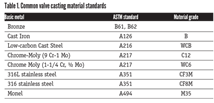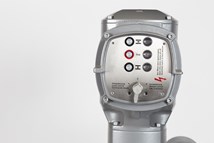VMA’s 2018 Market Outlook: Some Optimism, But Issues Remain
The attendees of VMA’s 2017 Market Outlook Workshop in Boston, Aug. 3-4, came away with a generally more positive outlook than they have for the last couple of years.
#VMAnews
Oil and Gas
John Spears of Spears and Associates noted that, while globally demand for oil continues to increase at about 1.5% annually, there is no indication that prices will grow much beyond $50 to $55 per barrel until at least 2020. While OPEC producers have said they are returning to the traditional exercise of trying to manage end-use inventories as a way of managing prices, the challenge comes from American producers who can and do increase production when the price warrants, and much faster than OPEC nations.
Regarding natural gas, Spears agreed with Ken Medlock (Center for Energy Studies at Rice University’s Baker Institute) who predicted the U.S. market will continue growing about 1.5 to 2% per year for the foreseeable future. Growth in demand is generally on the industrial side with some increase in consumption due to power generation. Residential and commercial gas consumption is not growing and is generally dependent on weather.
Medlock reminded the assemblage that much of the projected demand growth for energy will be in developing Asia, where there is a paucity of natural resource, and LNG is likely to play a critical role. While the U.S. is set to export large amounts of LNG, it is not the only player. It is third in the world behind Australia and Qatar.
Petrochemicals
Mark Eramo of IHS Markit pointed out that technological advantages and proximity to local markets are also driving investment in chemicals in the U.S., while structural changes in China, logistics and geo-political considerations must also be considered when making investments in this space. As long as natural gas in North America is at an advantageous price compared with oil, the prospects for building petrochemical plants are positive.
Mining
In a cautiously optimistic look at the mining industry, John R. Craynon, senior mining engineer for the Import Export Bank said that, during the last several mining meetings he’s attended, outlooks for this industry have been much more positive than in years past. “The global mining outlook is generally optimistic, and we are predicting an industry upturn in the next 1 to 2 years despite the fact that commodity prices have not been strong.” Craynon noted that exploration is growing, but, while some capital is available from the commercial sector and institutional lenders, it is limited because of the long delay in return on investment. It can be 20 years from first expenditure to first profit in the bank. The
Financial Markets
Michael Halloran of Robert W. Baird & Co. pointed out that most end markets for the valve industry appear to be stable or improving in 2017. Upstream oil and gas markets are recovering and chemical demand appears robust in 2017. In surveys conducted by Baird, 26% of respondents indicated that sales and orders were ahead of expectations for this year, and participants are reporting improvement in the last 10 weeks of the second quarter of 2017.
Construction
Water
Gene Koontz of Gannett Fleming explained that renewal and replacement of aging infrastructure, financing for capital improvements, long-term water supply availability and public understanding of the value of water are all challenges to this sector. “We have to get people to understand the value of water. But there is some room for optimism as long as there is continued economic growth. But not too hot,” Koontz warned. “Because if that happens, the price of copper doubles and it becomes too expensive to invest.”
Power
“In 2010, only 39% of identified power projects went ahead,” said Britt Burt, VP of global research for the power industry at Industrial Info Resources Project.“ But in 2017, about 44% of identified projects will proceed. This is important, because the power industry experiences some of the largest fallout rates of any other industry as projects compete against others for the same space.”
There is a wide and diverse fuel mix in the global mixture. Because of availability and cost of coal, it makes sense for Southeast Asian countries to look towards coal-fired generating capacity. But in North America, natural gas and renewables are dominant.
International Outlook
“We are witnessing a synchronized global upturn,” said Simona Mokuta, senior economist at State Street Global Advisors. “We went through an energy and commodity recession in 2014, but that’s over. You may not have prices accelerating to previous highs, but it is a huge improvement from a year ago.”
“Consumer spending has been the key driver of U.S. growth in recent years,” said Mokuta. “But you don’t want your economy to be driven just by one thing. We need business investment to pick up some of the baton for growth.”
Mokuta said that, cyclically, Europe is recovering, but they have much to make up. The problem is the structural issues in the way the Eurozone is set up. It poses many challenges for countries like Italy that are not competitive. “Growth in Canada is broadening, as well,” said Mokuta. “And it’s not just Toronto or Vancouver; the resource provinces are healing as well. In fact, the Bank of Canada finally started raising interest rates, so it’s a good sign.”
Cybersecurity
Sean Peasley of Deloitte said that, to get more information for maintenance and control, process control industries are trending toward more connectivity to enable predictive maintenance, track asset condition, part and system failures, and operating performance to maximize uptime. However, the internet was not originally built with security in mind; it was built for speed and availability. So, as we connect, it is the responsibility of everyone in an organization to be educated on the potential for attacks, and to be vigilant. This issue is of such importance that VALVE will be dedicating an entire Web feature to ways of protecting your enterprise from cyber attacks.
The U.S. Economy
According to Maria Luengo-Prado of the Federal Reserve Bank of Boston, there is currently no stimulus to the economy from the government. However, the outlook by the Fed for the rest of 2017 is strong despite secular stagnation inherent in the system. “We cannot get the growth we had in the past. You can’t compare it to the 1960s where real GDP was over 3%. Now it’s around 1.3%. While that is not the ideal we set at 2%, it is stable at this point.” Be sure to check the Fall 2017 print edition of VALVE Magazine for much more detail on the important information shared at this annual event.
Kate Kunkel is senior editor of VALVE Magazine.
RELATED CONTENT
-
Check Valves: The Most Important Valves in Your Process System
Check valves, as critical as they are for flow system performance, often don’t receive the respect they are due, said Arie Bregman, vice president and general manager, DFT, Inc., in a recent VMA presentation.
-
Virtual Valve Forum and Basics Event Draws Attendees from Across the Industry
More than 200 people from across the valve industry participated virtually in the VMA Valve Forum and Valve Basics event, which included 4 days of presentations on technical, manufacturing, management and marketing, valves 101, and valve repair.
-
ValvTechnologies and Severn Form Strategic Partnership
ValvTechnologies and Severn Glocon have reached a partnership agreement that will see collaboration between two of the world’s leading engineering and manufacturing companies specializing in innovative, high-end, severe-service valves.












 Unloading large gate valve.jpg;maxWidth=214)